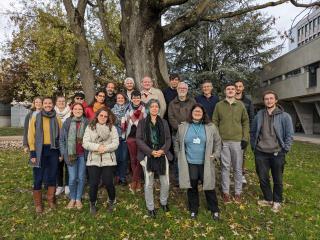Bioinformatics, Phylogeny and Evolutionary Genomics Group
Members
Maîtresse de conférences
UCBL
Tel: 04 72 44 84 87

Professeure des universités
UCBL
Tel: 33 04 26 23 44 76
Doctorante
UCBL
Enseignant-chercheur CPJ
UCBL
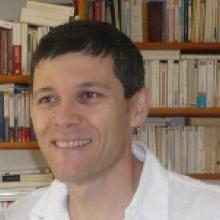
Directeur de recherche
CNRS
Tel: 33 04 72 44 62 97
Doctorant
CNRS
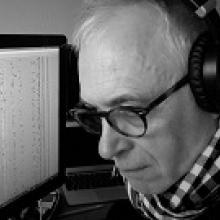
Professeur d'université émérite
UCBL
Tel: 04 72 44 85 60
Ingénieur d'études CDD
CNRS
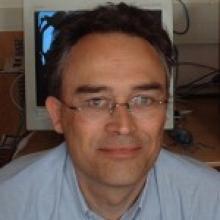
Directeur de recherche
CNRS
Tel: 33 04 72 43 11 67
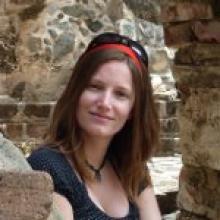
Maîtresse de conférences
UCBL
Tel: 33 04 72 43 29 18
Doctorante
UCBL
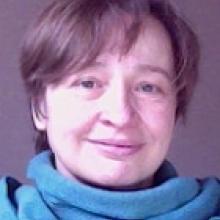
Chargée de recherche
CNRS
Tel: 33 04 72 44 85 60
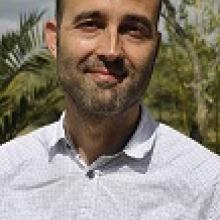
Directeur de recherche
CNRS
Tel: 04 72 44 84 87

Chargée de recherche
CNRS
Tel: 04 72 43 13 44
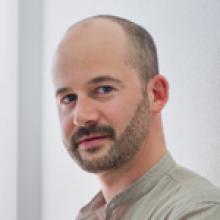
Directeur de recherche
CNRS

Maître de conférences
UCBL
Tel: 04 72 43 35 83
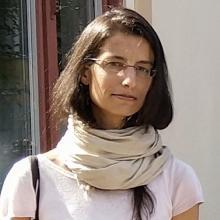
Chargée de recherche
CNRS
Tel: 04 72 44 81 42
Doctorant
CNRS
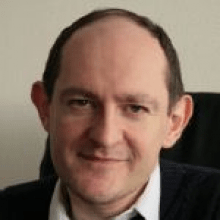
Directeur de recherche
CNRS
Tel: 33 04 72 44 62 96
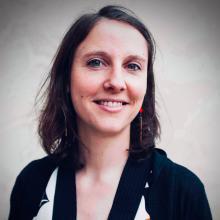
Chargée de recherche
CNRS
Tel: 04 72 43 26 28
Doctorant
UCBL
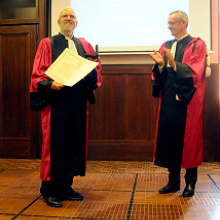
Chercheur invité
UCBL
Our group focuses on two main axes: phylogenomics (i.e. the inference of evolutionary history based on genomics data) and evolutionary genomics (understanding the molecular and population processes that drive genome evolution). We see genomes both as a subject of research (how do genomes evolve, why are they structured the way they are?), but also as a main source of empirical knowledge about the macroevolutionary patterns (what do they tell us about the history of life on Earth?), or about the phenotypes and life-history strategies of organisms. Our works heavily rely on methodological developments (bioinformatics, modeling and statistical inference).
Evolution of genome architecture and expression
Genomes are the result of a long-term evolutionary process, shaped by multiple evolutionary forces. Some genomic features are adaptive (i.e. are beneficial for the fitness of organisms), others result from non-adaptive processes (random drift and biased gene conversion - BGC) or are caused by conflicts between multiple levels of selection (e.g. meiotic drive or the spread of selfish genetic elements). We explore different aspects of genome architecture (base composition landscapes, genome structure and size, impact of transposable elements, …) or functioning (gene expression, lncRNAs, epigenetic landscapes, …), and try to disentangle the relative contribution of adaptive and non-adaptive processes to their evolution. For this purpose, we consider both the molecular mechanisms (mutation, repair, recombination) and the population processes (selection, drift, BGC, …) that shape genetic variation.
Phylogenomics
We are interested in reconstructing the history of life on Earth. This research unfolds along several axes. First, we develop phylogenomic databases of aligned genetic sequences (e.g. BIBI, RiboDB or HOGENOM). Second, we conduct methodological research on how to accurately reconstruct deep phylogenies, infer divergence times, reconstruct ancestral genetic sequences, gene repertoires and life-history traits. This methodological work is translated into publicly available software programs (e.g. SeaView, PhyloBayes, Coevol). Finally, we apply these approaches to several important problems, among which: reconstructing the phylogeny of animals, of archaea, or the global tree of life; using phylogenies and ancestral gene repertoires to investigate the evolution of complex systems and the emergence of molecular and cellular functions in the three domains of life; reconstructing ancestral genetic sequences, a research activity that has industrial and biotechnological applications.
Teaching and outreach
We teach at University Lyon 1 (Master Bioinfo@Lyon), INSA, ENS Lyon, we organize bioinformatics internships. We regularly give conferences on evolution (tree of life, human evolution, genetic diversity, …).
Prospective students and postdocs are invited to apply, as we often welcome visitors for internships or research projects.
Keywords: Molecular evolution and Population Genomics; Phylogenomics; Computational Genomics; Comparative genomics; Bioinformatics; Statistical inference.
Publications
Display of 91 to 120 publications on 1109 in total
Identifying the Best Approximating Model in Bayesian Phylogenetics: Bayes Factors, Cross-Validation or wAIC?
Systematic Biology . 72 : 616 - 638
Journal article
see the publicationGenes and sites under adaptation at the phylogenetic scale also exhibit adaptation at the population-genetic scale
Proceedings of the National Academy of Sciences of the United States of America . 120 ( 11 ) : e2214977120
Journal article
see the publicationDeciphering evolutionary trajectories of lactate dehydrogenases provides new insights into allostery.
Molecular Biology and Evolution . msad223
Journal article
see the publicationProposed mechanism for the selection of lactase persistence in childhood
BioEssays . 45 ( 7 )
Journal article
see the publicationBradyrhizobium commune sp. nov., isolated from nodules of a wide range of native legumes across the Australian continent
International Journal of Systematic and Evolutionary Microbiology . 73 ( 7 ) : 005971
Journal article
see the publicationPopulation designations in biomedical research: limitations and perspectives
HLA: Immune Response Genetics . 101 ( 1 ) : 3-15
DOI: 10.1111/tan.14852
Journal article
see the publicationSelf-compassion and savouring buffer the impact of the first year of the COVID-19 on PhD students' mental health
Stress and Health .
DOI: 10.1002/smi.3142
Journal article
see the publicationDosage compensation evolution in plants: theories, controversies and mechanisms
Philosophical Transactions of the Royal Society B: Biological Sciences . 377 ( 1850 ) : 20210222
Journal article
see the publicationMacSyFinder v2: An improved search engine to model and identify molecular systems in genomes
JOBIM .
Poster
see the publicationICEscreen: a valuable tool for automatic detection of ICEs and IMEs in Firmicutes
Réunion du GDR3546 Eléments transposables .
Conference paper
see the publicationICEscreen: a tool to detect Firmicute ICEs and IMEs, isolated or enclosed in composite structures
NAR Genomics and Bioinformatics . 4 ( 4 ) : lqac079
Journal article
see the publicationNAR Breakthrough Article Origins of transfer establish networks of functional dependencies for plasmid transfer by conjugation
Nucleic Acids Research . 51 ( 7 ) : 3001–3016
DOI: 10.1093/nar/gkac1079
Journal article
see the publicationStreptococcus suis as a reservoir of antibiotic resistance genes carried by Mobile Genetic Elements transferring by conjugation
5th International Caparica Congress in Antibiotic Resistance (IC2AR 2022) .
Conference paper
see the publicationEvolution of Plasmid Mobility: Origin and Fate of Conjugative and Nonconjugative Plasmids
Molecular Biology and Evolution . 39 ( 6 ) : msac115
Journal article
see the publicationIntracellular Salmonella Paratyphi A is motile and differs in the expression of flagella-chemotaxis, SPI-1 and carbon utilization pathways in comparison to intracellular S. Typhimurium
PLoS Pathogens . 18 ( 4 ) : 35 p.
Journal article
see the publicationModelling the spatiotemporal spread of beneficial alleles using ancient genomes
Preprint
see the publicationInterpreting mismatches between linguistic and genetic patterns among speakers of Tanimuka (Eastern Tukanoan) and Yukuna (Arawakan)
Interface Focus . 13
Journal article
see the publicationEthical challenges in genetic research among Philippine Indigenous Peoples: Insights from fieldwork in Zamboanga and the Sulu Archipelago
Frontiers in Genetics . 13 : 901515
Journal article
see the publicationThe transmission of human mitochondrial DNA in four‐generation pedigrees
Human Mutation . 43 : 1259-1267
DOI: 10.1002/humu.24390
Journal article
see the publicationThe social lives of isolates (and small language families): the case of the Northwest Amazon
Interface Focus . 13 ( 1 ) : 20220054
Journal article
see the publicationAssessing Human Genome-wide Variation in the Massim Region of Papua New Guinea and Implications for the Kula Trading Tradition
Molecular Biology and Evolution . 39
Journal article
see the publicationAncient genomes from the last three millennia support multiple human dispersals into Wallacea
Nature Ecology & Evolution . 6 : 1024 - 1034
Journal article
see the publicationA Nearly Neutral Model of Molecular Signatures of Natural Selection after Change in Population Size
Genome Biology and Evolution . 14 ( 5 )
DOI: 10.1093/gbe/evac058
Journal article
see the publicationHydrogen isotope measurements of bone and dental tissues from archaeological human and animal samples and their use as climatic and diet proxies
Journal of Archaeological Science . 147 : 105676
Journal article
see the publicationClimate conditions and dietary practices during the Second Iron Age studied through the multi-isotope analysis of bones and teeth from individuals of Thézy-Glimont, Picardie, France
Archaeological and Anthropological Sciences . 14 ( 4 ) : 61
Journal article
see the publicationModeling the spatiotemporal spread of beneficial alleles using ancient genomes
eLife . 11
DOI: 10.7554/eLife.73767
Journal article
see the publicationCodiversification of gut microbiota with humans
Science . 377 ( 6612 ) : 1328-1332
Journal article
see the publicationProtein conformational space at the edge of allostery: turning a nonallosteric malate dehydrogenase into an “allosterized” enzyme using evolution-guided punctual mutations
Molecular Biology and Evolution . 39 ( 9 ) : msac186
Journal article
see the publicationAn Improved Codon Modeling Approach for Accurate Estimation of the Mutation Bias
Molecular Biology and Evolution . 39
Journal article
see the publication
